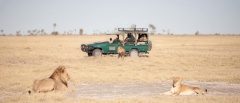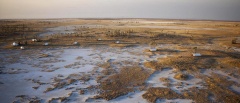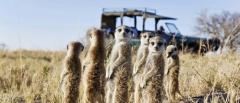Central Kalahari Game Reserve
A vast expanse of arid desert
Currently the largest wildlife reserve in the world, the Central Kalahari Game Reserve (CKGR) is to be experienced to be understood. This is not an area that is teeming with wildlife but is all about vast open expanses and a sense of Africa at its most awe-inspiring. Stretching west to east right across the central section of Botswana, the park plays a major role in shaping the entire country due to the deep Kalahari Sands that provide the core ground coverage.
Originally conceived in the early 1960s the CKGR was ostensibly a area of protected land for the San tribesmen of the region whose cultural identity and way of life was being severely encroached upon by modern practices. For around 30 years, until the 80s and 90s, the park was, to all intents and purposes a private reserve for the San with very limited access from the outside. Today the park is as open as it has ever been but, with only a handful of camp sites and even fewer properties, it still represents one of the least touched corners of Africa.
Topographically the park is a lot greener than many who are first time visitors would credit it for. While the main substrate is deep Kalahari sands, there is an almost continuous coverage of scrub bush across the entire park and also, in comparison with the other, more changeable areas of Botswana, a much less contrasting environment.
Best time to visit the Central Kalahari Game Reserve
September to December is classified as the hot season with temperatures during the day of up 45 degrees. This period is the hardest to drive on the sand as it is loose but this is also a good time for game viewing as the game gets congested around the watering holes.
December to March is also still hot but the main rains have arrived and so expect raging thunder storms that pass through swiftly and provide enough water to give grass coverage and spectacular flowers. The game tends to disperse slightly but is still there.
April to May is the cooler period and so for those that are not keen on heat but the grasses are at their highest so it can be harder to see game.
June to August is the coolest period in the year with mornings being very cold, dropping as low as negative 5 at times. This is also seen as one of the best periods for light and animal sightings.



